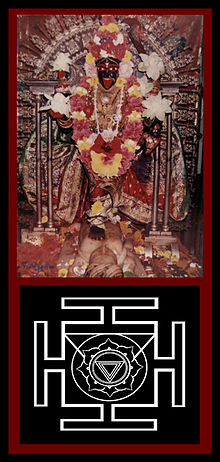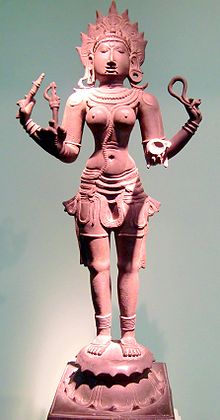- Kali
-
For other uses, see Kali (disambiguation)."Kalika" redirects here. For other uses, see Kalika (disambiguation)."The black one" redirects here. For the 2005 drone metal album, see Black One. For the male choral group, see The Black Ones.
Kali 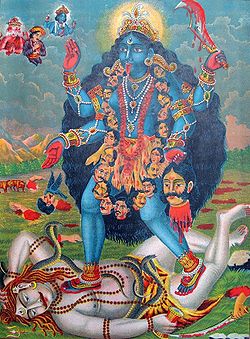
The goddess Kaligoddess of Time, Change Devanagari काली Sanskrit Transliteration Kālī Tamil script காளி Bengali script কালী Affiliation Devi, Mahavidya Abode Cremation grounds Mantra Om Krīm Kālyai namaḥ ,
Om Kapālinaye Namah,
Om Hrim Shrim Krim Parameshvari Kalike SvahaWeapon Scimitar Consort Shiva Mount Jackal Kālī (Sanskrit: काली, IPA: [kɑːliː]; Bengali: কালী; Punjabi: ਕਾਲੀ; Tamil: காளி; Telugu: కాళికాదేవి), also known as Kālikā (Sanskrit: कालिका, Bengali: কালিকা), is the Hindu goddess associated with power, shakti. The name Kali comes from kāla, which means black, time, death, lord of death, Shiva. Kali means "the black one". Since Shiva is called Kāla - the eternal time, Kālī, his consort, also means "Time" or "Death" (as in time has come). Hence, Kāli is considered the goddess of time and change. Although sometimes presented as dark and violent, her earliest incarnation as a figure of annihilation still has some influence. Various Shakta Hindu cosmologies, as well as Shākta Tantric beliefs, worship her as the ultimate reality or Brahman. She is also revered as Bhavatārini (literally "redeemer of the universe"). Comparatively recent devotional movements largely conceive Kāli as a benevolent mother goddess.[1]
Kālī is represented as the consort of Lord Shiva, on whose body she is often seen standing. She is associated with many other Hindu goddesses like Durga, Bhadrakali, Sati, Rudrani, Parvati and Chamunda. She is the foremost among the Dasa Mahavidyas, ten fierce Tantric goddesses.[2]
Contents
Etymology
Kālī is the feminine form of kāla ("black, dark coloured").[3] Kāla primarily means "black" but also means "time." Kālī means "the black one" and also "time" or "beyond time." Kāli is strongly associated with Shiva, and Shaivas derive her feminine name from the masculine Kāla (an epithet of Shiva). A nineteenth-century Sanskrit dictionary, the Shabdakalpadrum, states: कालः शिवः । तस्य पत्नीति - काली । kālaḥ śivaḥ । tasya patnīti kālī - "Shiva is Kāla, thus, his wife is Kāli."
Other names include Kālarātri ("black night"), as described above, and Kālikā ("relating to time"). Coburn notes that the name Kālī can be used as a proper name, or as a description of color.[4]
Kāli's association with black stands in contrast to her consort, Shiva, whose body is covered by the white ashes of the cremation ground (Sanskrit: śmaśāna) in which he meditates, and with which Kali is also associated, as śmaśāna-kālī.
Kālī is frequently confused with the word kali, as in Kali Yuga or the demon Kali. However, the words Kālī ("black, time") and kali ("weak, crude, inarticulate") are etymologically unrelated, and the goddess Kālī is not associated with Kali Yuga.
Origins
Hugh Urban notes that although the word Kālī appears as early as the Atharva Veda, the first use of it as a proper name is in the Kathaka Grhya Sutra (19.7).[5] Kali is the name of one of the seven tongues of Agni, the [Rigvedic] God of Fire, in the Mundaka Upanishad (2:4), but it is unlikely that this refers to the goddess. The first appearance of Kāli in her present form is in the Sauptika Parvan of the Mahabharata (10.8.64). She is called Kālarātri (literally, "black night") and appears to the Pandava soldiers in dreams, until finally she appears amidst the fighting during an attack by Drona's son Ashwatthama. She most famously appears in the sixth century Devi Mahatmyam as one of the shaktis of Mahadevi, and defeats the demon Raktabija ("Bloodseed"). The tenth-century Kalika Purana venerates Kāli as the ultimate reality or Brahman.
According to David Kinsley, Kāli is first mentioned in Hinduism as a distinct goddess around 600 CE, and these texts "usually place her on the periphery of Hindu society or on the battlefield."[6] She is often regarded as the Shakti of Shiva, and is closely associated with him in various Puranas. The Kalika Purana depicts her as the "Adi Shakti" (Fundamental Power) and "Para Prakriti" or beyond nature.
In Tantra
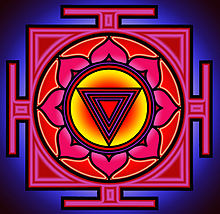 Kali Yantra
Kali Yantra
Goddesses play an important role in the study and practice of Tantra Yoga, and are affirmed to be as central to discerning the nature of reality as are the male deities. Although Parvati is often said to be the recipient and student of Shiva's wisdom in the form of Tantras, it is Kāli who seems to dominate much of the Tantric iconography, texts, and rituals.[7] In many sources Kāli is praised as the highest reality or greatest of all deities. The Nirvana-tantra says the gods Brahma, Vishnu, and Shiva all arise from her like bubbles in the sea, ceaselessly arising and passing away, leaving their original source unchanged. The Niruttara-tantra and the Picchila-tantra declare all of Kāli's mantras to be the greatest and the Yogini-tantra, Kamakhya-tantra and the Niruttara-tantra all proclaim Kāli vidyas (manifestations of Mahadevi, or "divinity itself"). They declare her to be an essence of her own form (svarupa) of the Mahadevi.[8]
In the Mahanirvana-tantra, Kāli is one of the epithets for the primordial sakti, and in one passage Shiva praises her:
- At the dissolution of things, it is Kāla [Time] Who will devour all, and by reason of this He is called Mahākāla [an epithet of Lord Shiva], and since Thou devourest Mahākāla Himself, it is Thou who art the Supreme Primordial Kālika. Because Thou devourest Kāla, Thou art Kāli, the original form of all things, and because Thou art the Origin of and devourest all things Thou art called the Adya [the Primordial One]. Re-assuming after Dissolution Thine own form, dark and formless, Thou alone remainest as One ineffable and inconceivable. Though having a form, yet art Thou formless; though Thyself without beginning, multiform by the power of Maya, Thou art the Beginning of all, Creatrix, Protectress, and Destructress that Thou art.[7]
The figure of Kāli conveys death, destruction, and the consuming aspects of reality. As such, she is also a "forbidden thing", or even death itself. In the Pancatattva ritual, the sadhaka boldly seeks to confront Kali, and thereby assimilates and transforms her into a vehicle of salvation.[9] This is clear in the work of the Karpuradi-stotra,[10] a short praise to Kāli describing the Pancatattva ritual unto her, performed on cremation grounds. (Samahana-sadhana)
- He, O Mahākāli who in the cremation-ground, naked, and with dishevelled hair, intently meditates upon Thee and recites Thy mantra, and with each recitation makes offering to Thee of a thousand Akanda flowers with seed, becomes without any effort a Lord of the earth. 0h Kāli, whoever on Tuesday at midnight, having uttered Thy mantra, makes offering even but once with devotion to Thee of a hair of his Shakti [his energy/female companion] in the cremation-ground, becomes a great poet, a Lord of the earth, and ever goes mounted upon an elephant.[9]
The Karpuradi-stotra clearly indicates that Kāli is more than a terrible, vicious, slayer of demons who serves Durga or Shiva. Here, she is identified as the supreme mistress of the universe, associated with the five elements. In union with Lord Shiva, who is said to be her spouse, she creates and destroys worlds. Her appearance also takes a different turn, befitting her role as ruler of the world and object of meditation.[11] In contrast to her terrible aspects, she takes on hints of a more benign dimension. She is described as young and beautiful, has a gentle smile, and makes gestures with her two right hands to dispel any fear and offer boons. The more positive features exposed offer the distillation of divine wrath into a goddess of salvation, who rids the sadhaka of fear. Here, Kali appears as a symbol of triumph over death.[12]
One of the most well respected author Dr. David Frawley, also known as Vāmdeva Shāstri, has explained the meaning of Beeja Mantra of Mā (Mother) Kāli in a lucid manner. The mantra is "AUM AIM HREEM KLEEM CHAMUNDAYE VICHCHE SWAHA |" Usually this mantra is sung during Bali or animal slaughter. But it has a dominating knowledge aspect to it, which is now very well understood in various world literatures.
Aum — Prayer; Aim — Symbolic of knowledge by Goddess Saraswati; Hreem — Symbolism of transformation; Kleem — Symbolism of confidence or strength; Chamundaye Vichche — Decapitation (Considered as fall of EGO) and Swaha — Sacrifice or Yajna prayer.
This interpretation states that Goddess Kāli through knowledge brings transformation in a devotee by excising the Ego, and then blesses the devotee with enormous strength and confidence.
So by this interpretation, animal slaughter is not required for prayering Goddess Kali as Dravya Yajna (material sacrifice). Prayers can be offered to Goddess Kali through Pure Knowledge or Gyan Yajna that is EGO sacrifice.
In Bengali tradition
Kali is also a central figure in late medieval Bengali devotional literature, with such devotees as Ramprasad Sen (1718–75). With the exception of being associated with Parvati as Shiva's consort, Kāli is rarely pictured in Hindu mythology and iconography as a motherly figure until Bengali devotions beginning in the early eighteenth century. Even in Bengāli tradition her appearance and habits change little, if at all.[13]
The Tantric approach to Kāli is to display courage by confronting her on cremation grounds in the dead of night, despite her terrible appearance. In contrast, the Bengali devotee appropriates Kāli's teachings adopting the attitude of a child, coming to love her unreservedly. In both cases, the goal of the devotee is to become reconciled with death and to learn acceptance of the way that things are. These themes are well addressed in Rāmprasād's work.[14]
Rāmprasād comments in many of his other songs that Kāli is indifferent to his wellbeing, causes him to suffer, brings his worldly desires to nothing and his worldly goods to ruin. He also states that she does not behave like a mother should and that she ignores his pleas:
- Can mercy be found in the heart of her who was born of the stone? [a reference to Kali as the daughter of Himalaya]
- Were she not merciless, would she kick the breast of her lord?
- Men call you merciful, but there is no trace of mercy in you, Mother.
- You have cut off the heads of the children of others, and these you wear as a garland around your neck.
- It matters not how much I call you "Mother, Mother." You hear me, but you will not listen.[15]
To be a child of Kāli, Rāmprasād asserts, is to be denied of earthly delights and pleasures. Kāli is said to refrain from giving that which is expected. To the devotee, it is perhaps her very refusal to do so that enables her devotees to reflect on dimensions of themselves and of reality that go beyond the material world.[15][16]
A significant portion of Bengali devotional music features Kāli as its central theme and is known as Shyama Sangeet ("Music of the Night"). Mostly sung by male vocalists, today even women have taken to this form of music. One of the finest singers of Shyāma Sāngeet is Pannalal Bhattacharya.
In Bengal, Kāli is venerated in the festival Kali Puja - the new moon day of Ashwin month which coincides with Diwali festival.
In a unique form of Kāli worship, Shantipur worships Kāli in the form of a hand painted image of the deity known as Poteshwari (meaning the deity drawn on a piece of cloth).
Mythology
Slayer of Raktabija
In Kāli's most famous myth, Durga and her assistants, the Matrikas, wound the demon Raktabija, in various ways and with a variety of weapons in an attempt to destroy him. They soon find that they have worsened the situation for with every drop of blood that is spilt from Raktabija he reproduces a clone of himself. The battlefield becomes increasingly filled with his duplicates.[17] Durga, in need of help, summons Kāli to combat the demons. It is said, in some versions, that Goddess Durga actually assumes the form of Goddess Kāli at this time.
The Devi Mahatmyam describes:
Out of the surface of her (Durga's) forehead, fierce with frown, issued suddenly Kali of terrible countenance, armed with a sword and noose. Bearing the strange khatvanga (skull-topped staff ), decorated with a garland of skulls, clad in a tiger's skin, very appalling owing to her emaciated flesh, with gaping mouth, fearful with her tongue lolling out, having deep reddish eyes, filling the regions of the sky with her roars, falling upon impetuously and slaughtering the great asuras in that army, she devoured those hordes of the foes of the devas.[18]
Kali destroys Raktabija by sucking the blood from his body and putting the many Raktabija duplicates in her gaping mouth. Pleased with her victory, Kali then dances on the field of battle, stepping on the corpses of the slain. Her consort Shiva lies among the dead beneath her feet, a representation of Kali commonly seen in her iconography as Daksinakali.[19]
In the Devi Mahatmya version of this story, Kali is also described as a Matrika and as a Shakti or power of Devi. She is given the epithet Cāṃuṇḍā (Chamunda), i.e. the slayer of the demons Chanda and Munda.[20] Chamunda is very often identified with Kali and is very much like her in appearance and habit.[21]
Daksinakali
 Bhadrakali (A gentle form of Kali), circa 1675.
Bhadrakali (A gentle form of Kali), circa 1675.
Painting; made in India, Himachal Pradesh, Basohli,
now placed in LACMA.In her most famous pose as Daksinakali, it is said that Kali, becoming drunk on the blood of her victims on the battlefield, dances with destructive frenzy. In her fury she fails to see the body of her husband, Shiva, who lies among the corpses on the battlefield.[22] Ultimately the cries of Shiva attract Kali's attention, calming her fury. As a sign of her shame at having disrespected her husband in such a fashion, Kali sticks out her tongue. However, some sources state that this interpretation is a later version of the symbolism of the tongue: in tantric contexts, the tongue is seen to denote the element (guna) of rajas (energy and action) controlled by sattva, spiritual and godly creatures who served as assassins.[23]
If Kali steps with right foot and holds sword in left hand she is considered to be Dakshina Kali.[24][25] Dakshina Kali Temple has important religious associations with Jagannath Temple and it is believed that Daksinakali is the guardian of the kitchen of the Lord Jagannath Temple. Puranic tradition says that in Puri, Lord Jagannath is regarded as Daksinakalika. Goddess Dakshinakali plays an important role in the 'Niti' of Saptapuri Amavasya.[26]
One South Indian tradition tells of a dance contest between Shiva and Kali. After defeating the two demons Sumbha and Nisumbha, Kali takes up residence in a forest. With fierce companions she terrorizes the surrounding area. One of Shiva's devotees becomes distracted while performing austerities, and asks Shiva to rid the forest of the destructive goddess. When Shiva arrives, Kali threatens him, claiming the territory as her own. Shiva challenges Kali to a dance contest, and defeats her when she is unable to perform the energetic Tandava dance. Although in this case Kali is defeated, and is forced to control her disruptive habits, there are very few other images or other myths depicting her in such a manner.[27]
Smashan Kali
If the Kali steps out with the left foot and holds sword in her right hand, she is terrible form of Mother, the Smashan Kali of cremation ground.[24][25] She is worshiped by tantrics, the followers of Tantra. According to them one's spiritual discipline practiced in smashan (cremation ground) brings success quickly. Sarda Devi, the consort of Ramakrishna Paramhansa worshiped Smashan Kali at Dakshineshwar.[28]
Maternal Kali
Another myth depicts the infant Shiva calming Kali. In this similar story, Kali again defeated her enemies on the battlefield and began to dance out of control, drunk on the blood of the slain. To calm her down and to protect the stability of the world, Shiva is sent to the battlefield, as an infant, crying aloud. Seeing the child's distress, Kali ceases dancing to take care of the helpless infant. She picks him up, kisses his head, and proceeds to breast feed the infant Shiva.[29] This myth depicts Kali in her benevolent, maternal aspect; something that is revered in Hinduism, but not often recognized in the West.
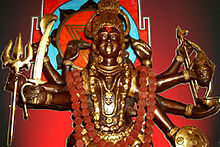 Ekamukhi or "One-Faced" Murti of Mahakali displaying ten hands holding the signifiers of various Devas
Ekamukhi or "One-Faced" Murti of Mahakali displaying ten hands holding the signifiers of various Devas
Mahakali
Main article: MahakaliMahakali (Sanskrit: Mahākālī, Devanagari: महाकाली), literally translated as Great Kali, is sometimes considered as a greater form of Kali, identified with the Ultimate reality of Brahman. It can also simply be used as an honorific of the Goddess Kali,[30] signifying her greatness by the prefix "Mahā-". Mahakali, in Sanskrit, is etymologically the feminized variant of Mahakala or Great Time (which is interpreted also as Death), an epithet of the God Shiva in Hinduism. Mahakali is the presiding Goddess of the first episode of the Devi Mahatmya. Here she is depicted as Devi in her universal form as Shakti. Here Devi serves as the agent who allows the cosmic order to be restored.
Iconography
Kali is portrayed mostly in two forms: the popular four-armed form and the ten-armed Mahakali form. In both of her forms, she is described as being black in color but is most often depicted as blue in popular Indian art. Her eyes are described as red with intoxication, and in absolute rage, her hair is shown disheveled, small fangs sometimes protrude out of her mouth, and her tongue is lolling. She is often shown naked or just wearing a skirt made of human arms and a garland of human heads. She is also accompanied by serpents and a jackal while standing on a seemingly dead Shiva, usually right foot forward to symbolize the more popular Dakshinamarga or right-handed path, as opposed to the more infamous and transgressive Vamamarga or left-handed path.[31]
In the ten-armed form of Mahakali she is depicted as shining like a blue stone. She has ten faces and ten feet and three eyes. She has ornaments decked on all her limbs. There is no association with Shiva.[32]
The Kalika Purana describes Kali as possessing a soothing dark complexion, as perfectly beautiful, riding a lion, four-armed, holding a sword and blue lotuses, her hair unrestrained, body firm and youthful.[33]
In spite of her seemingly terrible form, Kali Ma is often considered the kindest and most loving of all the Hindu goddesses, as she is regarded by her devotees as the Mother of the whole Universe. And, because of her terrible form she is also often seen as a great protector. When the Bengali saint Ramakrishna once asked a devotee why one would prefer to worship Mother over him, this devotee rhetorically replied, "Maharaj, when they are in trouble your devotees come running to you. But, where do you run when you are in trouble?"[34]
According to Ramakrishna, darkness is the Ultimate Mother, or Kali:
My Mother is the principle of consciousness. She is Akhanda Satchidananda; indivisible Reality, Awareness, and Bliss. The night sky between the stars is perfectly black. The waters of the ocean depths are the same; The infinite is always mysteriously dark. This inebriating darkness is my beloved Kali.
-Sri Ramakrishna
Throughout her history artists the world over have portrayed Kali in myriad poses and settings, some of which stray far from the popular description, and are sometimes even graphically sexual in nature. Given the popularity of this Goddess, artists everywhere will continue to explore the magnificence of Kali's iconography. This is clear in the work of such contemporary artists as Charles Wish, and Tyeb Mehta, who sometimes take great liberties with the traditional, accepted symbolism, but still demonstrate a true reverence for the Shakta sect.
Popular form
Classic depictions of Kali share several features, as follows:
Kali's most common four armed iconographic image shows each hand carrying variously a sword, a trishul (trident), a severed head and a bowl or skull-cup (kapala) catching the blood of the severed head.
Two of these hands (usually the left) are holding a sword and a severed head. The Sword signifies Divine Knowledge and the Human Head signifies human Ego which must be slain by Divine Knowledge in order to attain Moksha. The other two hands (usually the right) are in the abhaya (fearlessness) and varada (blessing) mudras, which means her initiated devotees (or anyone worshiping her with a true heart) will be saved as she will guide them here and in the hereafter.[35]
She has a garland consisting of human heads, variously enumerated at 108 (an auspicious number in Hinduism and the number of countable beads on a Japa Mala or rosary for repetition of Mantras) or 51, which represents Varnamala or the Garland of letters of the Sanskrit alphabet, Devanagari. Hindus believe Sanskrit is a language of dynamism, and each of these letters represents a form of energy, or a form of Kali. Therefore she is generally seen as the mother of language, and all mantras.[36]
She is often depicted naked which symbolizes her being beyond the covering of Maya since she is pure (nirguna) being-consciousness-bliss and far above prakriti. She is shown as very dark as she is brahman in its supreme unmanifest state. She has no permanent qualities — she will continue to exist even when the universe ends. It is therefore believed that the concepts of color, light, good, bad do not apply to her — she is the pure, un-manifested energy, the Adi-shakti.[37]
Mahakali form
Kali is depicted in the Mahakali form as having ten heads, ten arms, and ten legs. Each of her ten hands is carrying a various implement which vary in different accounts, but each of these represent the power of one of the Devas or Hindu Gods and are often the identifying weapon or ritual item of a given Deva. The implication is that Mahakali subsumes and is responsible for the powers that these deities possess and this is in line with the interpretation that Mahakali is identical with Brahman. While not displaying ten heads, an "ekamukhi" or one headed image may be displayed with ten arms, signifying the same concept: the powers of the various Gods come only through Her grace.
Shiva in Kali iconography
In both these images she is shown standing on the prone, inert or dead body of Shiva. There is a mythological story for the reason behind her standing on what appears to be Shiva's corpse, which translates as follows:
Once Kali had destroyed all the demons in battle, she began a terrific dance out of the sheer joy of victory. All the worlds or lokas began to tremble and sway under the impact of her dance. So, at the request of all the Gods, Shiva himself asked her to desist from this behavior. However, she was too intoxicated to listen. Hence, Shiva lay like a corpse among the slain demons in order to absorb the shock of the dance into himself. When Kali eventually stepped upon her husband she realized her mistake and bit her tongue in shame.[38]
The Tantric interpretation of Kali standing on top of her husband is as follows:
The Shiv tattava (Divine Consciousness as Shiva) is inactive, while the Shakti tattava (Divine Energy as Kali) is active. Shiva, or Mahadeva represents Brahman, the Absolute pure consciousness which is beyond all names, forms and activities. Kali, on the other hand, represents the potential (and manifested) energy responsible for all names, forms and activities. She is his Shakti, or creative power, and is seen as the substance behind the entire content of all consciousness. She can never exist apart from Shiva or act independently of him, i.e., Shakti, all the matter/energy of the universe, is not distinct from Shiva, or Brahman, but is rather the dynamic power of Brahman.[39]
While this is an advanced concept in monistic Shaktism, it also agrees with the Nondual Trika philosophy of Kashmir, popularly known as Kashmir Shaivism and associated most famously with Abhinavagupta. There is a colloquial saying that "Shiva without Shakti is Shava" which means that without the power of action (Shakti) that is Mahakali (represented as the short "i" in Devanagari) Shiva (or consciousness itself) is inactive; Shava means corpse in Sanskrit and the play on words is that all Sanskrit consonants are assumed to be followed by a short letter "a" unless otherwise noted. The short letter "i" represents the female power or Shakti that activates Creation. This is often the explanation for why She is standing on Shiva, who is either Her husband and complement in Shaktism or the Supreme Godhead in Shaivism.
To properly understand this complex Tantric symbolism it is important to remember that the meaning behind Shiva and Kali does not stray from the non-dualistic parlance of Shankara or the Upanisads. According to both the Mahanirvana and Kularnava Tantras, there are two distinct ways of perceiving the same absolute reality. The first is a transcendental plane which is often described as static, yet infinite. It is here that there is no matter, there is no universe and only consciousness exists. This form of reality is known as Shiva, the absolute Sat-Chit-Ananda — existence, knowledge and bliss. The second is an active plane, an immanent plane, the plane of matter, of Maya, i.e., where the illusion of space-time and the appearance of an actual universe does exist. This form of reality is known as Kali or Shakti, and (in its entirety) is still specified as the same Absolute Sat-Chit-Ananda. It is here in this second plane that the universe (as we commonly know it) is experienced and is described by the Tantric seer as the play of Shakti, or God as Mother Kali.[40]
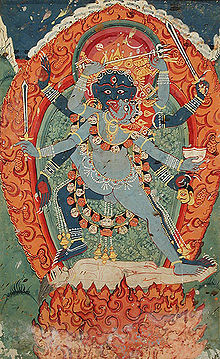 Kali and Bhairava (the terrible form of Shiva) in Union, 18th century, Nepal
Kali and Bhairava (the terrible form of Shiva) in Union, 18th century, Nepal
From a Tantric perspective, when one meditates on reality at rest, as absolute pure consciousness (without the activities of creation, preservation or dissolution) one refers to this as Shiva or Brahman. When one meditates on reality as dynamic and creative, as the Absolute content of pure consciousness (with all the activities of creation, preservation or dissolution) one refers to it as Kali or Shakti. However, in either case the yogini or yogi is interested in one and the same reality — the only difference being in name and fluctuating aspects of appearance. It is this which is generally accepted as the meaning of Kali standing on the chest of Shiva.[39]
Although there is often controversy surrounding the images of divine copulation, the general consensus is benign and free from any carnal impurities in its substance. In Tantra the human body is a symbol for the microcosm of the universe; therefore sexual process is responsible for the creation of the world. Although theoretically Shiva and Kali (or Shakti) are inseparable, like fire and its power to burn, in the case of creation they are often seen as having separate roles. With Shiva as male and Kali as female it is only by their union that creation may transpire. This reminds us of the prakrti and purusa doctrine of Samkhya wherein prakāśa- vimarśa has no practical value, just as without prakrti, purusa is quite inactive. This (once again) stresses the interdependencies of Shiva and Shakti and the vitality of their union.[41]
Gopi Krishna proposed that Kali standing on the dead Shiva or Shava (Sanskrit for dead body) symbolised the helplessness of a person undergoing the changing process (psychologically and physiologically) in the body conducted by the Kundalini Shakti.[42]
Development
In the later traditions, Kali has become inextricably linked with Shiva. The unleashed form of Kali often becomes wild and uncontrollable, and only Shiva is able to tame her. This is both because she is often a transformed version of one of his consorts and because he is able to match her wildness. The ancient text of Kali Kautuvam describes her competition with Shiva in dance, from which the sacred 108 Karanas appeared. Shiva won the competition by acting the urdva tandava, one of the Karanas, by raising his feet to his head. Other texts describe Shiva appearing as a crying infant and appealing to her maternal instincts. While Shiva is said to be able to tame her, the iconography often presents her dancing on his fallen body, and there are accounts of the two of them dancing together, and driving each other to such wildness that the world comes close to unravelling.
Shiva's involvement with Tantra and Kali's dark nature have led to her becoming an important Tantric figure. To the Tantric worshippers, it was essential to face her Curse, the terror of death, as willingly as they accepted Blessings from her beautiful, nurturing, maternal aspect. For them, wisdom meant learning that no coin has only one side: as death cannot exist without life, so life cannot exist without death. Kali's role sometimes grew beyond that of a chaos—which could be confronted—to that of one who could bring wisdom, and she is given great metaphysical significance by some Tantric texts. The Nirvāna-tantra clearly presents her uncontrolled nature as the Ultimate Reality, claiming that the trimurti of Brahma, Visnu and Rudra arise and disappear from her like bubbles from the sea. Although this is an extreme case, the Yogini-tantra, Kamakhya-tantra and the Niruttara-tantra declare her the svarupa (own-being) of the Mahadevi (the great Goddess, who is in this case seen as the combination of all devis).
The final stage of development is the worshipping of Kali as the Great Mother, devoid of her usual violence. This practice is a break from the more traditional depictions. The pioneers of this tradition are the 18th century Shakta poets such as Ramprasad Sen, who show an awareness of Kali's ambivalent nature. Ramakrishna, the 19th century Bengali saint, was also a great devotee of Kali; the western popularity of whom may have contributed to the more modern, equivocal interpretations of this Goddess. Rachel McDermott's work, however, suggests that for the common, modern worshipper, Kali is not seen as fearful, and only those educated in old traditions see her as having a wrathful component. Some credit to the development of Devi must also be given to Samkhya. Commonly referred to as the Devi of delusion, Mahamaya, acting in the confines of (but not being bound by) the nature of the three gunas, takes three forms: Maha-Kali, Maha-Lakshmi and Maha-Saraswati, being her tamas-ika, rajas-ika and sattva-ika forms. In this sense, Kali is simply part of a larger whole.
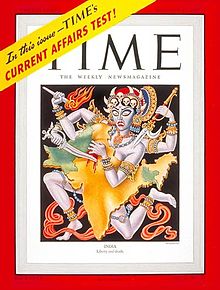 1947 TIME Magazine cover by Boris Artzybasheff depicting a self-hurting Kālī as a symbol of the partition of India
1947 TIME Magazine cover by Boris Artzybasheff depicting a self-hurting Kālī as a symbol of the partition of India
Like Sir John Woodroffe and Georg Feuerstein, many Tantric scholars (as well as sincere practitioners) agree that, no matter how propitious or appalling you describe them, Shiva and Devi are simply recognizable symbols for everyday, abstract (yet tangible) concepts such as perception, knowledge, space-time, causation and the process of liberating oneself from the confines of such things. Shiva, symbolizing pure, absolute consciousness, and Devi, symbolizing the entire content of that consciousness, are ultimately one and the same—totality incarnate, a micro-macro-cosmic amalgamation of all subjects, all objects and all phenomenal relations between the "two." Like man and woman who both share many common, human traits yet at the same time they are still different and, therefore, may also be seen as complementary.[43]
Worshippers prescribe various benign and horrific qualities to Devi simply out of practicality. They do this so they may have a variety of symbols to choose from, symbols which they can identify and relate with from the perspective of their own, ever-changing time, place and personal level of unfolding. Just like modern chemists or physicists use a variety of molecular and atomic models to describe what is unperceivable through rudimentary, sensory input, the scientists of ontology and epistemology must do the same. One of the underlying distinctions of Tantra, in comparison to other religions, is that it allows the devotee the liberty to choose from a vast array of complementary symbols and rhetoric that which suits one's evolving needs and tastes. From an aesthetic standpoint, nothing is interdict and nothing is orthodox. In this sense, the projection of some of Devi's more gentle qualities onto Kali is not sacrilege and the development of Kali really lies in the practitioner, not the murthi.
A TIME magazine article of October 27, 1947, used Kālī as a symbol and metaphor for the human suffering in British India during its partition that year.[44]
A statue of Kali appears on the Phoenix Force cover to Night of the Thuggee (1985).
In New Age and Neopaganism
An academic study of Western Kali enthusiasts noted that, "as shown in the histories of all cross-cultural religious transplants, Kali devotionalism in the West must take on its own indigenous forms if it is to adapt to its new environment."[45] The adoption of Kali by the West has raised accusations of cultural misappropriation:
"A variety of writers and thinkers [...] have found Kali an exciting figure for reflection and exploration, notably feminists and participants in New Age spirituality who are attracted to goddess worship. [For them], Kali is a symbol of wholeness and healing, associated especially with repressed female power and sexuality. [However, such interpretations often exhibit] confusion and misrepresentation, stemming from a lack of knowledge of Hindu history among these authors, [who only rarely] draw upon materials written by scholars of the Hindu religious tradition. The majority instead rely chiefly on other popular feminist sources, almost none of which base their interpretations on a close reading of Kali's Indian background. [...] The most important issue arising from this discussion – even more important than the question of 'correct' interpretation – concerns the adoption of other people's religious symbols. [...] It is hard to import the worship of a goddess from another culture: religious associations and connotations have to be learned, imagined or intuited when the deep symbolic meanings embedded in the native culture are not available."[46]
Notes
- ^ http://www.srilankaguardian.org/2011/08/in-veneration-of-nallurs-vira-ma-kali.html
- ^ Encyclopedia International, by Grolier Incorporated Copyright in Canada 1974. AE5.E447 1974 031 73-11206 ISBN 0-7172-0705-6 page 95
- ^ Pāṇini 4.1.42
- ^ Coburn, Thomas; Devī-Māhātmya &mdāash; Crystallization of the Goddess Tradition; Motilal Banarsidass, Delhi, 1984; ISBN 81-208-0557-7 pages 111–112.
- ^ Hugh Urban, "India's Darkest Heart: Kali in the Colonial Imagination," Encountering Kali: In the Margins, at the Center, in the West, edited by Rachel Fell McDermott and Jeffrey Kripal (Berkeley: University of California Press, 2003)
- ^ David Kinsley, Tantric Visions of the Divine Feminine: The Ten Mahavidyas (Berkeley: University of California Press, 1997), p. 70
- ^ a b D. Kinsley p. 122.
- ^ D. Kinsley p. 122–123.
- ^ a b D. Kinsley p. 124.
- ^ Karpuradi Stotra, Tantrik Texts Vol IX, Arthur Avalon (Sir John Woodroffe), Calcutta Agamanusandhana Samiti, 1922.
- ^ D. Kinsley p. 124–125.
- ^ D. Kinsley p. 125.
- ^ D. Kinsley p. 126.
- ^ D. Kinsley p.125–126.
- ^ a b D. Kinsley p. 128.
- ^ MantraOnNet.com:Text & Images of Kali
- ^ D. Kinsley p. 118.
- ^ Devi Mahatmyam, Swami Jagadiswarananda, Ramakrishna Math, 1953.
- ^ D. Kinsley p. 118–119.
- ^ Wangu p. 72.
- ^ Kinsley p. 241 Footnotes.
- ^ D. Kinsley pp. 119, 130.
- ^ McDermott 2003.
- ^ a b [1] Kali: the black goddess of Dakshineswar By Elizabeth U. Harding
- ^ a b [2]
- ^ DAKSHINAKALI TEMPLE
- ^ D. Kinsley p. 119.
- ^ Smashan Kali
- ^ D. Kinsley p. 131.
- ^ Offering Flowers, Feeding Skulls By June McDaniel p.257
- ^ The Art of Tantra, Philip Rawson, Thames & Hudson, 1973.
- ^ Sankaranarayanan. S. Devi Mahatmya. p 127.
- ^ David Gordon White (ed.), Tantra in Practice, ISBN 81-208-1778-8 p466.
- ^ Sri Ramakrishna (The Great Master), Swami Saradananda, Ramakrishna Math, 1952, page 624, Sri Ramakrishna: The Spiritual Glow, Kamalpada Hati, P.K. Pramanik, Orient Book Co., 1985, pages 17–18.
- ^ Tantra in Practice, David Gordon White, Princeton Press, 2000, page 477.
- ^ Tantra in Practice, David Gordon White, Princeton Press, 2000, page 475.
- ^ Tantra in Practice, David Gordon White, Princeton Press, 2000, page 463–488.
- ^ Hindu Gods & Goddesses, Swami Harshananda, Ramakrishna Math, 1981, pages 116–117.
- ^ a b Tantra (The Path of Ecstasy), Georg Feuerstein, Shambhala, 1998, pages 70–84, Shakti and Shâkta, Arthur Avalon (Sir John Woodroffe), Oxford Press/Ganesha & Co., 1918.
- ^ Tantra in Practice, David Gordon White, Princeton Press, 2000, page 463–488, Shakti and Shâkta, Arthur Avalon (Sir John Woodroffe), Oxford Press/Ganesha & Co., 1918.
- ^ Impact of Tantra on Religion & Art, T. N. Mishra, D.K. Print World, 1997, V.
- ^ Krishna, Gopi (1993)Living with Kundalini: (Shambhala, 1993 ISBN 0877739471).
- ^ Tantra (The Path of Ecstasy), Georg Feuerstein, Shambhala, 1998, Shakti and Shâkta, Arthur Avalon (Sir John Woodroffe), Oxford Press/Ganesha & Co., 1918.
- ^ The Trial of Kali, TIME Magazine, October 27, 1947.
- ^ McDermott, Rachel Fell, "The Western Kali", in Hawley, John Stratton & Wulff, Donna M., Devi: The Goddess in India, p. 305.
- ^ McDermott, Rachel Fell, "The Western Kali", in Hawley, John Stratton & Wulff, Donna M., Devi: The Goddess in India, pp. 281–305.
References
- Shakti and Shâkta, Arthur Avalon (Sir John Woodroffe), Oxford Press/Ganesha & Co., 1918
- Sri Ramakrishna (The Great Master), Swami Saradananda, Ramakrishna Math,1952
- Devi Mahatmyam, Swami Jagadiswarananda, Ramakrishna Math, 1953
- The Art of Tantra, Philip Rawson, Thames & Hudson, 1973
- Hindu Gods & Goddesses, Swami Harshananda, Ramakrishna Math, 1981
- Sri Ramakrishna: The Spiritual Glow, Kamalpada Hati, P.K. Pramanik, Orient Book Co., 1985
- Hindu Goddesses: Visions of the Divine Feminine in the Hindu Religious Tradition, David R. Kinsley, University of California Press, 1988
- Kali (The Black Goddess of Dakshineswar) Elizabeth U. Harding, Nicolas Hays, 1993
- Impact of Tantra on Religion and Art, T. N. Mishra, D.K. Print World, 1997
- Indian Art (revised), Roy C. Craven, Thames & Hudson, 1997
- A Dictionary of Buddhist and Hindu Iconography (Illustrated), Frederick W. Bunce, D.K. Print World, 1997
- Tantra (The Path of Ecstasy), Georg Feuerstein, Shambhala, 1998
- Oxford Concise Dictionary of World Religions, John Bowker, Oxford Press, 2000
- Tantra in Practice, David Gordon White, Princeton Press, 2000
- Encountering Kali: In the Margins, at the Center, in the West, Rachel Fell McDermott, Berkeley : University of California Press, 2003
Further reading
- Shanmukha Anantha Natha and Shri Ma Kristina Baird, Divine Initiation Shri Kali Publications (2001) ISBN 0-9582324-0-7 - Has a chapter on Mahadevi with a commentary on the Devi Mahatmyam from the Markandeya Purana.
- Swami Jagadiswarananda, tr., Devi Mahatmyam Chennai, Ramakrishna Math. ISBN 81-7120-139-3
- Devadatta Kali, In Praise of The Goddess, The Devimahatmyam and Its Meaning ISBN 0-89254-080-X
- Rachel Fell McDermott, Encountering Kali: In the Margins, at the Center, in the West (ISBN 0-520-23240-2)
- Ajit Mookerjee, Kali: The Feminine Force ISBN 0-89281-212-5
- Swami Satyananda Saraswati, Kali Puja ISBN 1-887472-64-9
- Ramprasad Sen, Grace and Mercy in Her Wild Hair: Selected Poems to the Mother Goddess ISBN 0-934252-94-7
- Avalon, Arthur (1922). Hymn to Kali: Karpuradi-Stotra. Luzac & Co., London. http://books.google.co.in/books?id=XrAIJR37dJoC&printsec=frontcover.
- Sir John Woodroffe (a.k.a. Arthur Avalon) Hymns to the Goddess and Hymn to Kali ISBN 81-85988-16-1
- Robert E. Svoboda, Aghora, at the left hand of God ISBN 0-914732-21-8
- Dimitri Kitsikis, L'Orocc, dans l'âge de Kali ISBN 2-89040-359-9
- Lex Hixon, Mother of the Universe: Visions of the Goddess and Tantric Hymns of Enlightenment ISBN 0-8356-0702-X
- Neela Bhattacharya Saxena, In the Beginning is Desire: Tracing Kali's Footprints in Indian Literature ISBN 818798161X
- The Goddess Kali of Kolkata (ISBN 81-7476-514-X) by Shoma A. Chatterji
- Dictionary of Hindu Lore and Legend (ISBN 0-500-51088-1) by Anna Dallapiccola
- In Praise of The Goddess: The Devimahatmyam and Its Meaning (ISBN 0-89254-080-X) by Devadatta Kali
- Tantric Visions of the Divine Feminine: The Ten Mahavidyas (ISBN 0-520-20499-9) by David Kinsley
- Offering Flowers, Feeding Skulls: Popular Goddess Worship in West Bengal (ISBN 0-195-16791-0) by June McDaniel
- Mother of My Heart, Daughter of My Dreams: Kali and Uma in the Devotional Poetry of Bengal (ISBN 0-19-513435-4) by Rachel Fell McDermott
- Seeking Mahadevi: Constructing the Identities of the Hindu Great Goddess (ISBN 0-791-45008-2) Edited by Tracy Pintchman
- The Rise of the Goddess in the Hindu Tradition (ISBN 0-7914-2112-0) by Tracy Pintchman
External links
- Kali at the Open Directory Project
Mahavidya Kali · Tara · Tripura Sundari · Bhuvaneshvari · Bhairavi · Chhinnamasta · Dhumavati · Bagalamukhi · Matangi · Kamalatmika
Hindu deities and texts Gods 
Goddesses Texts Time in religion and mythology Time and fate deities · Eternity · Eschatology · Golden Age · Divination · Prophecy · Fate · CalendarCategories:- Destroyer goddesses
- Time and fate goddesses
- Mother goddesses
- Hindu goddesses
- Forms of Parvati
- Mahavidyas
- Shaktism
- Sanskrit words and phrases
- Death goddesses
Wikimedia Foundation. 2010.


